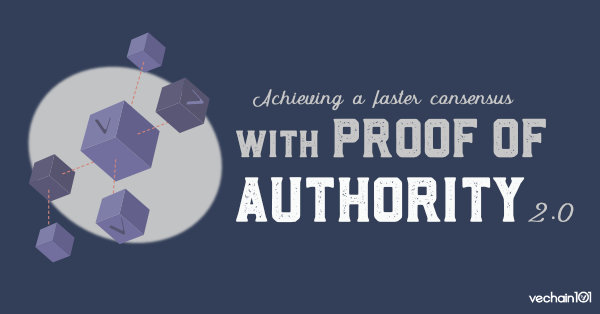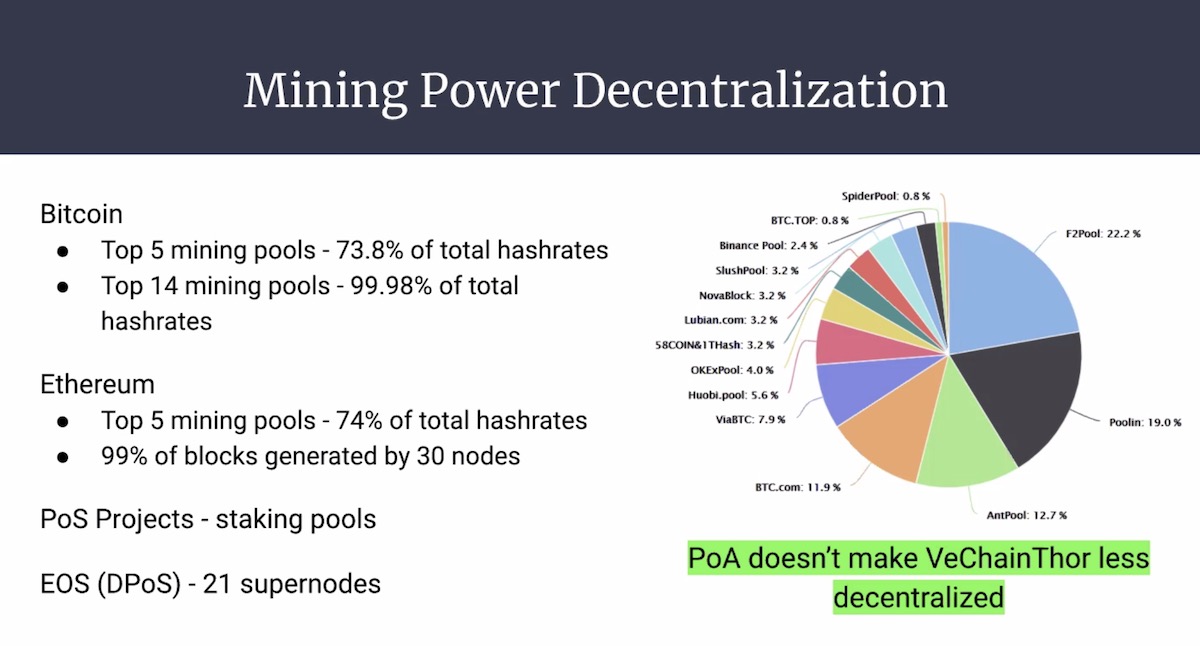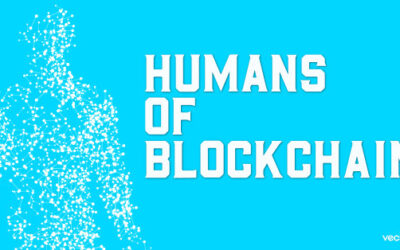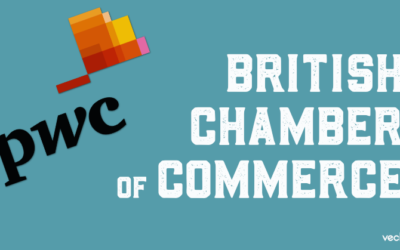As more companies join the ecosystem, it is increasingly important to ensure that the network can cope with high activity growth. With this in mind, VeChain is consistently improving the technology behind VeChainThor; currently developing a new consensus algorithm and having at least 42 patents around the world.
In VeChain’s 6th Bootcamp, Peter Zhou – VeChain Chief Scientist – and Zhijie (aka Max) Ren – VeChain Senior Research Scientist – addressed some of the most common questions and shared what to expect from the new PoA 2.0 – SURFACE.
What is PoA?
VeChainThor uses a Proof-of-Authority (PoA) consensus; where one of the 101 pre-approved validators (Authority Masternodes) are randomly selected to generate the next block. The model avoids computational competition and enables a faster and more efficient block production. The limited number of “miners”, however, creates centralisation concerns which, according to Peter, is a misconception. As demonstrated by him in the chart below, depending on the perspective, the presence of mining pools in other blockchains actually makes them more centralised than VeChain.
VeChainThor’s scaling solution: It’s all about quality not quantity
There are many ways to scale a blockchain network such as increasing the bandwidth, increasing the block size and/or block frequency, sharding, etc.
VeChain, however, opted to optimise bandwidth with its PoA 2.0 SURFACE (Secure Use-case-adaptive Relatively Fork-free Approach of Chain Extension) consensus.
When a new block is created, time is used in communication overheads, transmission and validation of data, and reaching a consensus to elect the next node to generate a block though. By maximising the percentage of time spent in transmitting data (blue part), more transactions can be included into the block, raising the number transactions per second (TPS) and improving bandwidth efficiency.
Consensus under PoA 1.0:
Consensus under PoA 2.0:
 To reduce achieve this, PoA 2.0 proposes the following changes:
To reduce achieve this, PoA 2.0 proposes the following changes:
Delayed validation: instead of validating the block in the consensus round it is generated, validation is delayed to the next round. This allows the network to transmit and validate blocks simultaneously and in parallel; essentially saving time.
Epoch based random beacon scheduling: instead of deciding on “real-time” which node will generate the next block, a schedule is randomly created in advance (for example one day beforehand) to decide which, and in which order, Authority Masternodes will produce new blocks. This eliminates the time wasted in reaching a consensus every time a block is created.
Relatively fork-free approach: when a new block is generated, it takes time for the block data to reach the Authority Masternodes. Since Masternodes are kept in different locations, they receive the information at different times. By removing block validation and the consensus process from the “round”, the new data doesn’t have enough time to fully propagate, leading to asynchrony problems between nodes and giving the chance for a malicious player to fork the chain and double spend. To avoid this, PoA 2.0 introduces a verifiable random function (VRF) mechanism whereby blocks need to be endorsed by a randomly selected smaller pool of Authority Masternodes to be confirmed. This helps dilute the power of the singular Authority Masternode creating the new block and can potentially reduce the probability of malicious forks to 1%.
To find out more about PoA2.0 SURFACE visit VeChain’s Medium announcement and the preprint paper.
A business perspective of VeChainThor
Many businesses have moved away from Ethereum onto VeChainThor, including Deloitte, Fresh Supply Co and Real Items.
During VeChain’s 7th webinar, Ken Woodruff -co-founder and CTO of Real Items- shared the main advantages VeChainThor brings to his firm.
What is Real Items
Real Items aims to bridge the gap between blockchain and consumers, focusing on easy user onboarding and usability. To this goal, they have created VeChainThor integrations for some of the most popular online platforms, such as Shopify and HubSpot, and are currently developing new WeChat, WooCommerce (WordPress) and DeFi enabled supply chain management solutions.
VeChainThor’s competitive advantage for enterprises
For Ken, some of the main benefits of building in VeChainThor are:
- Two-token VET/VTHO model – helps to keep stable and predictable fees (essential to forecast and manage business risks)
- Multi-Task Transaction (MTT) – allows the ordering and bundling of item creation into one transaction. Simplifying the process and reducing transaction costs
- Fee delegation – enables sponsors to pay for transfers fees on behalf of users, avoiding customers having to manage cryptocurrencies (vital for enterprise adoption). Currently, fee delation is used in more than 90% of clauses
- Fixed 101 Authority Masternodes – leads to consistent and predictable block time (10s), allows faster sync between nodes and allows quicker core feature development cycles and hardware and software network updates
- Solid APIs – ability to work with easier Connect and JAVA API
- Easy access to VeChain core dev team – allows developers to readily receive technical support when needed
- VeChain Foundation backing – financial support from the foundation in the form of VTHO donations when milestones are achieved
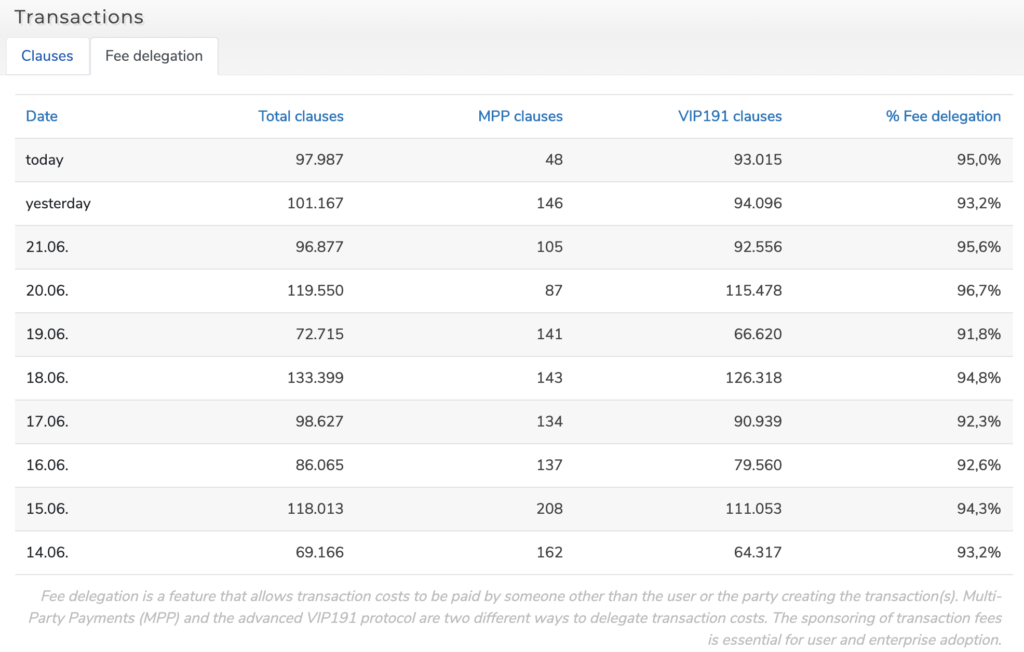
Percentage of fee delegation clauses in the last 10 days. Credit to VeChainStats.com
VeChain prides itself for being the leading enterprise blockchain platform and businesses are at the core of its innovations. With an ambitious goal to drive mass adoption, it’s great to see that them back their words with actions and have enterprises validate its business friendly ecosystem.

